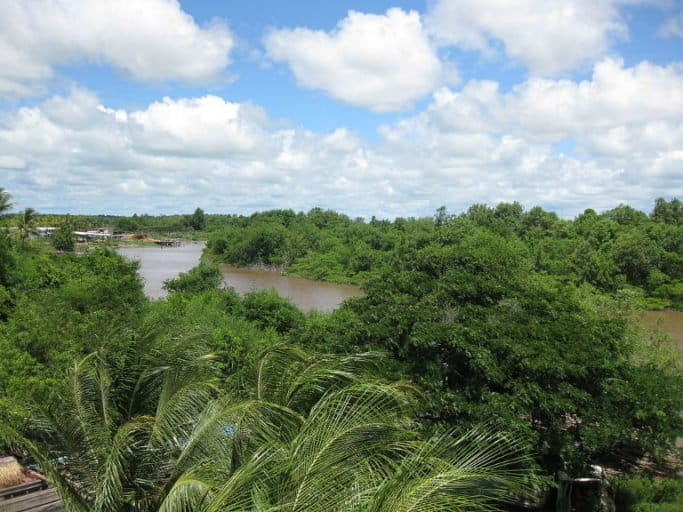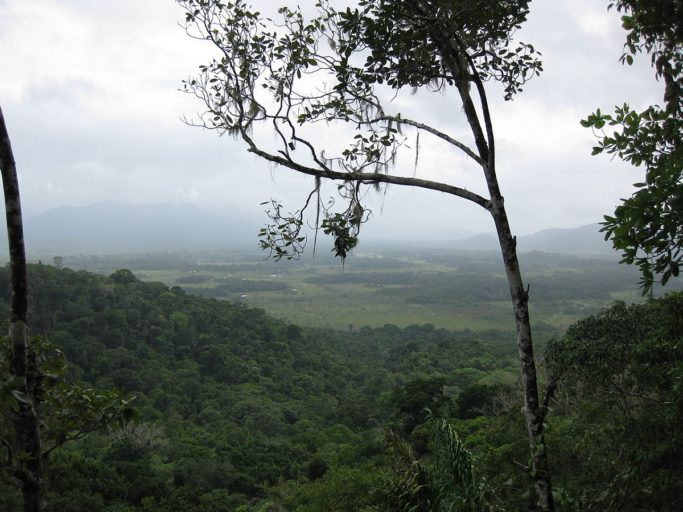- After six long years, Guyana has signed on to an agreement with the EU that should prove instrumental in securing a profitable position for the small Latin American country in the global legal logging industry.
- The agreement will eventually allow Guyana to issue logging licenses under the EU’s Forest Law Enforcement, Governance and Trade (EU FLEGT) initiative.
- Government leaders in the EU and Guyana also anticipate that the agreement and partnership will lead to improved forest management and a decrease in illegal logging.
GEORGETOWN, Guyana – Guyana has initialed a Voluntary Partnership Agreement (VPA) with the European Union (EU) to tackle illegal logging, improve forest management and boost the legal timber trade in the South American country.
It has been an exhausting six years since Guyana first began the process back in December 2012. A deadline at the end of 2017 was missed, but now Guyana is finally one step closer to being able to issue licenses under the EU’s Forest Law Enforcement, Governance and Trade (EU FLEGT) initiative.
However, forest operators here still have a while to wait before they’ll be able to sell wood under a FLEGT licence. According to the Guyana Forestry Commission, implementation of the VPA could take between three and five years, and will cost an estimated $30 million.
Last year, Guyana recorded its lowest rate of deforestation since 2010. So why is it pursuing approval under the EU FLEGT Action Plan? Access to European markets is one reason. With a FLEGT license, timber exported from Guyana to the EU doesn’t need to undergo due diligence checks to satisfy the EU Timber Regulation (EUTR), which prohibits the selling of illegally harvested timber products.

The EU FLEGT Facility’s website lists further benefits, including improving transparency, clarifying laws, widening participating in decision-making processes, and supporting sustainable forest management. This year, Guyana enacted new regulations under its 2009 Forests Act. It also gazetted its Code of Practice for Forests Operations, which was first implemented on a voluntary basis back in 1998.
Signs of other efforts to tighten up logging operations can be found in the local media. For example, the Guyana Chronicle reported the approval of 200 forest-operation permits during the year up to August. In the article, the Environmental Protection Agency’s executive director, Khemraj Parsram, is quoted as saying this authorization involves an evaluation of the operation and setting out terms and conditions which they must comply by, “to ensure that there are adequate environmental and social benefits and [to] ensure the protection of the environment.”
Meanwhile, an independent audit of the GFC carried out by Soil Association Certification Limited and published in the first quarter of 2018, reported, “The systems and procedures [of the GFC] were operating effectively, and that satisfactory compliance with the specific indicators could be demonstrated.” Although it noted the need the need for a fully functioning electronic system to tackle some “inconsistencies in data and information.”
It also shared data on breaches of GFC guidelines, which added up to 25 for large concessions in 2017, and 612 for small concessions.

The EU FLEGT facility is also keen to emphasise the agreement’s support for the rights of Guyana’s indigenous peoples – who, it states, own 14 percent of the country’s land (covered by some 1.3 million hectares of forest). A key issue for Guyana’s indigenous people is land rights. Although direct action isn’t in the cards under the VPA, there is a pledge to, “provide support to the Grievance and Redress Mechanism of the current Amerindian Land Titling Project”.
Representatives of the indigenous peoples involved in the lengthy process (including the Ministry of Indigenous Peoples Affairs, the Indigenous People’s Commission and the National Toshaos Council) will be looking closely to see how that support materializes – given that land rights is such a hot topic for many Amerindian communities.
Paul Pierre, Vice Chair of the National Toshaos Council (NTC), attended the initialling of the VPA and has also joined some of the local EU FLEGT consultations. His own village of Kwebanna in Region One has a sawmill, which was funded some years ago by an EU micro-project program.
“For us, if we can get access to the European market, then we can upgrade and pursue value-added [products] – it would be a good thing for us as a community. But I know there’s still a far way to go on it,” Pierre said.
Consultations and discussions will need to continue as implementation is rolled out to answer the questions and concerns some still have.
“Many communities are demarcated and right next to them you have forest that has marketable lumber,” Pierre said. “Many have asked for extensions to their land…we want to be legal, but somebody got to give us that legality.”
Some forest operators are also struggling to meet some of GFC’s more technical requirements, he said, and as such face non-compliance fines.
Training is available, but there will need to be continued capacity building to ensure EU FLEGT guidelines are adhered to.
“It’ll take some time to get accustomed to – after … years [when] you could do it as you want to,” Pierre said. “Indigenous people have been sustaining and preserving the forest for years and we have to because it’s our livelihood: we live off the land, we live off the forest and we cannot afford to destroy it.”
